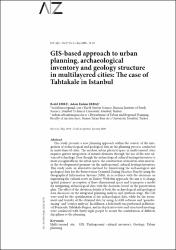Mimar Sinan Güzel Sanatlar Üniversitesi Açık Bilim, Sanat Arşivi
Açık Bilim, Sanat Arşivi, Mimar Sinan Güzel Sanatlar Üniversitesi tarafından doğrudan ve dolaylı olarak yayınlanan; kitap, makale, tez, bildiri, rapor gibi tüm akademik kaynakları uluslararası standartlarda dijital ortamda depolar, Üniversitenin akademik performansını izlemeye aracılık eder, kaynakları uzun süreli saklar ve yayınların etkisini artırmak için telif haklarına uygun olarak Açık Erişime sunar.MSGSÜ'de Ara
GIS-based approach to urban planning, archaeological inventory and geology structure in multilayered cities: The case of Tahtakale in Istanbul
| dc.contributor.author | Emre, Bedel | |
| dc.contributor.author | Erbaş, Adem Erdem | |
| dc.date.accessioned | 2022-06-08T18:31:24Z | |
| dc.date.available | 2022-06-08T18:31:24Z | |
| dc.date.issued | 2020 | |
| dc.identifier.issn | 2564-7474 | |
| dc.identifier.uri | https://hdl.handle.net/20.500.14124/89 | |
| dc.identifier.uri | https://doi.org/10.5505/itujfa.2020.34735 | |
| dc.description.abstract | This study presents a new planning approach within the context of the integrationof archaeological and geological data in the planning process conductedin multi-layered cities. The modern urban physical space in multi-layered citiesrequires greater integration of natural elements through the use of the new advancedtechnology. Even though the archaeological cultural heritage/inventory ismore recognizable in the urban space, the construction of modern cities increasesthe developmental pressure on the underground cultural heritage/inventory.This study seeks an alternative method for transferring the archaeological andgeological data for the Preservation-Oriented Zoning Practice Plan by using theGeographical Information Systems (GIS), in accordance with the decisions onregistering the cultural assets in Turkey. With this approach, the aim is to changespatial planners’ perception of three-dimensional space and to propose a modelfor integrating archaeological data with the decisions based on the preservationplan. The effect of the elevation details of both the archaeological and geologicaldata discussed on the integrated planning analysis and synthesis stage. The GISwere used for the spatialization of the archaeological data, while for the assessmentand transfer of the obtained data by using ArcGIS software and "georeferencing"and "overlay analysis". In addition, a field study was performed in HistoricalPeninsula, Tahtakale Region, and in-depth interviews and structured meetingswere conducted with thirty-eight people to secure the contribution of differentdisciplines to the planning. | en_US |
| dc.language.iso | eng | en_US |
| dc.publisher | Istanbul Teknik Universitesi, Faculty of Architecture | |
| dc.relation.ispartof | A/Z ITU Journal of the Faculty of Architecture | en_US |
| dc.rights | info:eu-repo/semantics/openAccess | en_US |
| dc.subject | GIS | |
| dc.subject | Geology | |
| dc.subject | Multi-layered city | |
| dc.subject | Underground cultural inventory | |
| dc.subject | Urban planning | |
| dc.title | GIS-based approach to urban planning, archaeological inventory and geology structure in multilayered cities: The case of Tahtakale in Istanbul | en_US |
| dc.type | article | en_US |
| dc.department | Mimar Sinan Güzel Sanatlar Üniversitesi, Mimarlık Fakültesi, Şehir ve Bölge Planlama Bölümü | en_US |
| dc.institutionauthor | Erbaş, Adem Erdem | |
| dc.identifier.volume | 17 | en_US |
| dc.identifier.issue | 2 | en_US |
| dc.identifier.startpage | 31 | en_US |
| dc.identifier.endpage | 52 | en_US |
| dc.relation.publicationcategory | Makale - Ulusal Hakemli Dergi - Kurum Öğretim Elemanı | en_US |
| dc.authorscopusid | 6504031350 | |
| dc.identifier.scopus | 2-s2.0-85090624687 | |
| dc.identifier.trdizinid | TkRBMk1EYzRPQT09 | en_US |
| dc.identifier.trdizinid | 406078 | |
| dc.indekslendigikaynak | Scopus | |
| dc.indekslendigikaynak | TR-Dizin |















